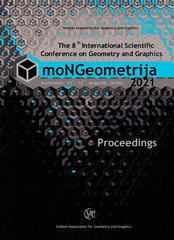Приказ основних података о документу
Visualization of geodynamic changes of terrain using Google Earth Pro and Qgis
| dc.creator | Martinenko, Anastasija | |
| dc.creator | Obradović, Marija | |
| dc.date.accessioned | 2021-12-16T13:41:44Z | |
| dc.date.available | 2021-12-16T13:41:44Z | |
| dc.date.issued | 2021 | |
| dc.identifier.isbn | 978-86-6060-086-0 | |
| dc.identifier.uri | https://grafar.grf.bg.ac.rs/handle/123456789/2527 | |
| dc.description.abstract | The paper presents a way of visualizing terrain changes in the observed time period, caused by natural disasters such as landslide. The application of the Google Earth Pro application for generation of DSM (Digital Area Model) data is presented, and the software package Qgis with accompanying tools was used for analysis, modelling and visualization of the obtained data. The settlement of Umka in the city municipality of Čukarica in Belgrade was adopted as an area of interest. Part of Umka territory is a landslide, a geodynamic process which is considered a natural disaster. Thus, as such, it is interesting to monitor changes in the terrain over time period. Changes were monitored within intervals of 8 years, for a period of 2011 to 2019. In Google Earth Pro, DSM was generated via isohypses. Data were generated for different dates using Historical imagery option and compared over time. Obtaining DSM through isohypses in this manner is an efficient and cheap way to obtain terrain data. Therefore, despite certain inaccuracies compared to standard practice, it can be applied in cases where a high level of accuracy is not required, and it is necessary to prepare data in a short time. The method presented in this paper is suitable for a preliminary review of the condition of the terrain, without the need for more demanding procedures. The processing of the generated DSM was performed with Qgis software application. For the selected area of interest, the DSM data was exported from Google Earth Pro and loaded into Qgis. By applying the existing tools, additional terrain analyzes of the area were performed. As a result, terrain models are presented, showing clearly visible changes that occurred within a given time period. The described procedure itself provides several important advantages compared to standard procedures: the use of freeware, rapidity of obtaining results, simultaneous visualization of changes, simplicity of the procedure and obtaining results accurate enough for immediate evaluation of the situation on site. In addition, due to its illustrative nature, this method can be used for educational purposes. | sr |
| dc.language.iso | en | sr |
| dc.publisher | Serbian Society for Geometry and Graphics (SUGIG) | sr |
| dc.publisher | Faculty of Mechanical Engineering, University of Belgrade | sr |
| dc.relation | info:eu-repo/grantAgreement/MESTD/inst-2020/200092/RS// | sr |
| dc.rights | openAccess | sr |
| dc.rights.uri | https://creativecommons.org/licenses/by/4.0/ | |
| dc.source | Proceedings of 8th International Scientific Conference “moNGeometrija 2021” | sr |
| dc.subject | DSM | sr |
| dc.subject | isohypses | sr |
| dc.subject | Qgis | sr |
| dc.subject | Google Earth Pro | sr |
| dc.subject | landslide | sr |
| dc.title | Visualization of geodynamic changes of terrain using Google Earth Pro and Qgis | sr |
| dc.type | conferenceObject | sr |
| dc.rights.license | BY-NC-ND | sr |
| dc.rights.holder | Faculty of Mechanical Engineering, University of Belgrade | sr |
| dc.citation.epage | 185 | |
| dc.citation.spage | 178 | |
| dc.description.other | http://mongeometrija.com/zbornici/2021 | sr |
| dc.identifier.fulltext | http://grafar.grf.bg.ac.rs/bitstream/id/9861/bitstream_9861.pdf | |
| dc.identifier.rcub | https://hdl.handle.net/21.15107/rcub_grafar_2527 | |
| dc.type.version | publishedVersion | sr |

